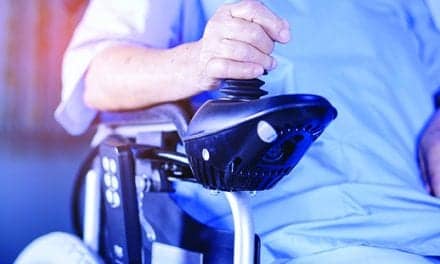When conducting clinical research, investigators aim to control as many variables as possible so it is easier to examine the effectiveness of new treatments. However, this sometimes means strict requirements lead to only a narrow population of patients being eligible to be enrolled in a trial, such as those with a pre-stroke disability.
As stroke researchers continue to make breakthroughs to improve care, this approach has led to a large portion of patients who had a pre-stroke disability being overlooked, says Eva Mistry, MBBS, MSCI, from the University of Cincinnati.
“We typically measure improvement related to a stroke treatment based on if the patient’s function got better or back to normal or not,” said Mistry, assistant professor in the Department of Neurology and Rehabilitation medicine in UC’s College of Medicine and a UC Health physician at the UC Gardner Neuroscience Institute. “You can imagine if your patient starts with a functional disability, they can’t get to excellent function because they have a certain baseline limitation, and we end up excluding these patients.”
Mistry said this practice disproportionately excludes underrepresented minority patients, older patients and female patients, as these groups are statistically more likely to be living with a disability in the U.S.
Since these patients are not included in research, guidelines from organizations like the American Heart Association and American Stroke Association typically recommend that new effective treatments should only be given to patients with no history of a pre-stroke disability.
“So the clinicians kind of take that as gospel and they hedge and say that we can’t offer this treatment,” Mistry said. “It’s not necessarily because it doesn’t work, but it’s just because we never studied this patient population before.”
Mistry is the principal investigator of a new study with $9.6 million funding support from the Patient-Centered Outcomes Research Institute (PCORI) that will examine the effectiveness of a stroke treatment for patients with a pre-stroke disability, reportedly one of the first studies to focus on this population.
Research Focus
The overarching goal of the research is to produce data that describes stroke outcomes among patients with a pre-stroke disability, Mistry said. Nearly 30% of patients who have ischemic strokes caused by a blood clot in the brain have a pre-stroke disability.
“We can then offer tools and data to future researchers and scientists such that they don’t reflexively exclude patients based on their baseline disability from any research, and thereby evidence-based clinical care,” she said.
Specifically, the research team will focus on the effectiveness of a treatment called an endovascular thrombectomy (EVT). This is a minimally invasive procedure that uses a catheter to remove a blood clot from a blood vessel in the brain for ischemic stroke patients and is highly effective, reducing death and disability in two out of every five patients with an ischemic stroke.
Over four years, approximately 1,100 patients at 12 sites across the United States will be enrolled in the study, with researchers comparing outcomes between a subset who received EVT and a subset who did not. Enrollment is projected to begin in fall 2023.
“We’re going to collect a lot of usual outcomes that we measure for stroke, but also a lot of novel outcomes like granular measurement of their disability and function before and after stroke, the quality of life before and after stroke, their social support and the caregiving burden before and after stroke,” Mistry said.
Community Input
Mistry noted that even when focusing on this specific patient group, it is possible to enroll a cohort of patients that does not look like the overall population of people in the U.S. with a disability. PCORI stresses the importance of patient and community engagement and representation in its funded studies, and community partners have been involved with the study since its early stages.
“We have worked over a couple of years now with these partners to make sure that our study design reflects what is important to them to measure as outcomes,” Mistry said. “We will work with them on an ongoing basis throughout the project to make sure that we are enrolling a diverse patient population that represents the population with the condition that we hope to study.”
A patient partner on the study, Yolanda Vaughn, has worked with Vanderbilt University over the last 15 years as a community trainer, Community Engagement Studio facilitator and patient advocate.
“This project aligns with my desires to help researchers get the information they need in order to get drugs, therapies and resources to communities faster,” Vaughn said. “I believe that it’s valuable work and when one of us is sick, all of us are sick. So if we’re all better, our communities are better, our world is better.”
As she continues to advise the researchers, Vaughn said she sees herself as sort of an “evangelist” for the project, letting patients and doctors know what is happening, answering questions and helping to support enrollment efforts.
“I think there’s value in including everyone when appropriate into research, and I think that means we have to work on building trust in the community, that we’re inviting you into this project and we’re going to treat you well, we’re going to respect you, and our intent is not to harm you,” she said. “The more we can get more people to the table, of all races, ethnicities, genders, the more rich our data will be. The ability to save lives increases.”
Vaughn said it is important to have community organizations, partners and advocates on board to serve as a bridge to the patient community. This work includes translating medical jargon so community members understand it, but also valuing the experiences and knowledge of the community and centering their voices within the research.
“There’s a long delay in treatments where doctors have found a medicine or cure, but it’s 10 or 15 years later before it can actually get in the hands of patients. And having a project like this may help us reduce that time,” she said. “I would like to think that at the end of the study we will have information that will help change the trajectory for people who are pre-stroke or have those possibilities of stroke to get the treatment that they need.”
Shani Woods, PhD, is a caregiver partner on the study, bringing her expertise in research as an assistant professor of social work at Austin Peay State University and her personal experience. Woods and her husband, Timothy, take care of her parents, both of whom have had strokes. She credits Mistry with saving her mother’s life following her stroke, and Mistry was the primary neurologist for both of Woods’ parents at one point.
With her social work background, Woods said she has been able to access and utilize resources. Her parents have health insurance, but that is not the case for every caregiver. Even when well-resourced, caregivers’ needs can often be neglected.
“A lot of the focus is on the patient, and that’s absolutely so important because you want the patient to be well, but I think a lot of times people don’t really consider the needs of the person who is providing the care,” Woods said. “[Such as] mental health needs, perhaps their need for a break or their need for respite or even just to ask how they are doing.”
Woods has been trained in clinical and translational research with a focus on health disparities, health equity and understanding psychosocial issues, bringing a unique perspective to the study.
“We look at things from the angle of what’s going on in the environment,” she said. “We look at what the caregiver needs or what the patient needs and how we make these systems function together.”
Woods said she is excited to be part of a study that will contribute to new knowledge and advancements in stroke care, particularly as African Americans and other communities of color are disproportionately affected by strokes.
“It’s going to be groundbreaking, because first of all it’s inclusive, and also it lends the opportunity to speak more to health disparities,” she said. “I think it has the impact to really help shape and inform the way clinicians interact with and operate with their patients in the hospital setting because they’re going to have more of a psychosocial perspective that I’m sharing.”
PCORI Funding
The study was selected through a highly competitive review process in which patients, caregivers and other stakeholders joined scientists to evaluate the proposals. It was selected for funding through a PCORI program designed to support research that produces results that are broadly applicable to a diverse range of patients and care situations and can be more quickly taken up in routine clinical practice.
UC’s Mistry said this is her first experience leading a study with a PCORI funding award, and the process has been “eye-opening.”
“PCORI’s main focus is patient-centered outcomes. They put the utmost importance to ensure the study results are available and translatable for all end users,” Mistry said. “ It has been a really wonderful experience working with them thus far.”
Many clinical studies test whether an approach to care works under carefully controlled conditions in specialized research centers, but health care is rarely delivered in such optimized situations and settings. Pragmatic clinical studies like this test a treatment’s effectiveness in “real-world” practice situations, such as typical hospitals and outpatient clinics, and also can include a wider range of study participants, making their findings more generally applicable.
“This project was selected for PCORI funding not only for its scientific merit and commitment to engaging patients and other health care stakeholders, but also for its conduct in real-world settings,” said Nakela L. Cook, MD, PCORI executive director. “It has the potential to answer an important question about treatment for patients with a pre-stroke disability and fill a crucial evidence gap. We look forward to following the study’s progress and working with the University of Cincinnati to share its results.”
[Source(s): University of Cincinnati, EurekAlert]





